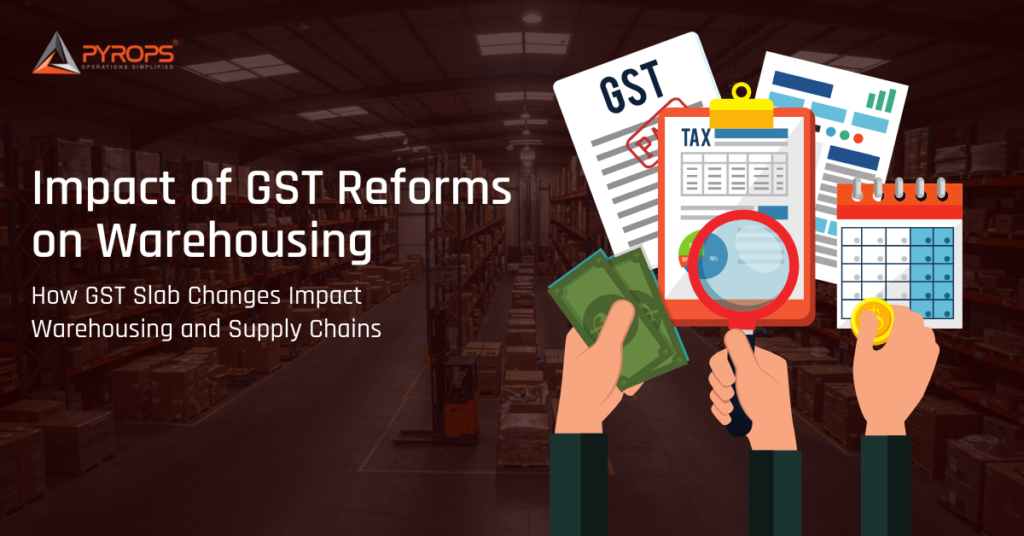The Goods and Services Tax (GST) has been in place for years, streamlining India’s indirect tax system. Yet, GST isn’t static—it evolves. Every Union Budget or GST Council meeting can bring about slab changes for certain product categories. When chocolates move from 18% to 28%, or small appliances shift down a slab, the change might sound like just a number on paper. But for businesses, it unleashes a chain reaction across supply chains and warehouses.
Let’s unpack how these slab changes play out beyond compliance, and why warehouses often become the frontline for execution.
1. The MRP Conundrum
GST slab changes almost always trigger a revision in Maximum Retail Price (MRP). For warehouses, this creates immediate challenges:
- Re-stickering & relabeling: Millions of units in stock may need updated MRPs before dispatch.
- Segregation of batches: Old-MRP and new-MRP stock must be stored separately to avoid billing errors.
- Dispatch delays: Warehouses can’t ship until goods are compliant, leading to bottlenecks.
Example: When the slab for certain FMCG goods shifted, one distributor had to halt shipments for two days while temporary staff relabeled 8 lakh units across three facilities.
2. Phase-Out of Old Stock
Old stock that carries outdated MRPs or tax rates often becomes a liability. Warehouses face:
- Reverse logistics burden: Unsold stock might have to be shipped back to manufacturers for relabeling.
- Stock liquidation pressure: Businesses may push old inventory into the market at discounts, impacting margins.
- Audit sensitivity: Warehouses become compliance hotspots during transitions, with auditors checking every carton.
Without batch-level visibility, businesses risk non-compliance or worse—dead stock eating up capital.
3. Operational Overheads: Re-Stickering as a Mini-Factory
Re-stickering sounds simple but can overwhelm warehouse ops:
- Labor spikes: Additional contract labor is required for manual relabeling.
- Accuracy issues: Human error in applying stickers to the wrong SKU or carton can trigger compliance fines.
- Space congestion: Staging areas fill up with stock waiting to be reprocessed, disrupting regular flows.
Warehouses that rely on WMS-driven workflows (scan-validation, automated batch segregation) handle transitions faster with fewer mistakes.
4. SKU Proliferation & Grammage Tweaks
When slab changes make certain price points unattractive, companies often respond with grammage adjustments—for example, launching a 95g pack instead of 100g to hit a consumer-friendly price.
Implications for warehousing:
- More SKUs: Increased SKU count requires re-slotting and location reassignment.
- Higher pick complexity: Similar-looking SKUs (e.g., 95g vs. 100g) raise the risk of mis-picks.
- Forecasting challenges: Demand for older grammages drops unpredictably, making inventory planning tricky.
5. Impact on Distribution Networks
GST slab changes affect not just warehouses but also the flow of goods:
- Demand swings: Higher slabs may suppress demand, forcing warehouses to carry excess stock. Lower slabs may trigger a demand surge, leading to stockouts.
- Dealer pushback: Distributors and retailers may resist taking deliveries of old-priced stock.
- Transport scheduling: When dispatches pause for relabeling, transporters face idle time and re-scheduling headaches.
6. Cash Flow & Inventory Valuation
Tax slab changes can alter the landed cost of inventory overnight. Warehouses must coordinate with finance teams to:
- Revalue existing stock: Goods lying in the warehouse may need accounting adjustments.
- Manage credit notes/debit notes: Manufacturers often issue these to compensate distributors for slab-driven price changes. Warehouses must supply accurate stock data to enable reconciliation.
- GST return compliance: Inventory transitions must align with GST filings to avoid mismatches.
7. Technology & System Updates
ERP, WMS, and billing systems must all be updated to reflect the new slabs. This isn’t trivial:
- Master data updates: Every affected SKU’s tax configuration must be revised.
- Interface testing: Integration points (ERP ↔ WMS ↔ POS) must be validated to ensure GST rate consistency.
- Training: Warehouse operators and billing clerks must be reoriented to handle new workflows.
8. Shelf Life & Expiry Risks
For perishable or fast-moving categories (like food & beverages, pharma), slab changes can create expiry risk:
- If re-stickering delays are prolonged, products inch closer to expiry dates.
- Retailers may prefer newer batches, leaving old stock stranded.
- Warehouses need expiry-aware picking (FIFO/FEFO) to mitigate wastage.
9. Customer & Market Communication
It’s not just an internal supply chain issue. Warehouses must align with sales teams to:
- Communicate to retailers: Clear guidelines on what MRPs are valid, and for which batches.
- Handle returns: Smooth processes for old stock returns prevent customer frustration.
- Support promotions: Some companies run clearance sales for old stock; warehouses need to segregate and prioritize dispatch.
Conclusion
GST slab changes might look like a tax tweak, but their impact cascades into inventory accuracy, warehouse operations, supply chain flow, compliance, and customer relationships.
Warehouses that treat these changes as “just another compliance exercise” often scramble with chaos. Those that invest in visibility (WMS), automation, and proactive planning turn disruption into a competitive edge.
After all, in modern supply chains, adaptability isn’t optional—it’s survival.

